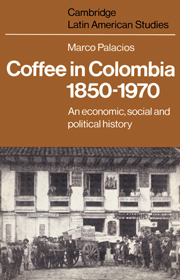Book contents
- Frontmatter
- Contents
- List of tables
- List of figures
- List of maps
- Preface
- Acknowledgements
- 1 The Colombian export economy in the second half of the nineteenth century
- 2 The making of an oligarchy
- 3 Land and society in central Colombia in the second half of the nineteenth century
- 4 The internal structure of the coffee haciendas, 1870–1930
- 5 Living conditions and internal contradictions in the hacienda structure
- 6 Inflation, devaluation, and export taxes, 1870–1904
- 7 Crisis and transition towards the second cycle of expansion, 1903–10
- 8 Private appropriation of public lands in the west
- 9 Sociopolitical elements in antioquen̄o colonization
- 10 Coffee expansion and the strengthening of the Liberal model of development, 1910–50
- 11 The international cycle and coffee policies confronting the peasant, 1930–70
- Appendix 1 Sample of coffee estates in Cundinamarca and Antioquia, 1870–98
- Appendix 2 Piece-rate wages on two coffee haciendas, 1879–1933
- Appendix 3 Concentration of the coffee export trade (percentage controlled by 20 leading companies), 1933–70
- Appendix 4 Foreign exchange rates in Colombia, 1870–1970
- Weights and measures
- Glossary
- Notes
- Biblography
- Index
- CAMBRIDGE LATIN AMERICAN STUDIES
7 - Crisis and transition towards the second cycle of expansion, 1903–10
Published online by Cambridge University Press: 06 October 2009
- Frontmatter
- Contents
- List of tables
- List of figures
- List of maps
- Preface
- Acknowledgements
- 1 The Colombian export economy in the second half of the nineteenth century
- 2 The making of an oligarchy
- 3 Land and society in central Colombia in the second half of the nineteenth century
- 4 The internal structure of the coffee haciendas, 1870–1930
- 5 Living conditions and internal contradictions in the hacienda structure
- 6 Inflation, devaluation, and export taxes, 1870–1904
- 7 Crisis and transition towards the second cycle of expansion, 1903–10
- 8 Private appropriation of public lands in the west
- 9 Sociopolitical elements in antioquen̄o colonization
- 10 Coffee expansion and the strengthening of the Liberal model of development, 1910–50
- 11 The international cycle and coffee policies confronting the peasant, 1930–70
- Appendix 1 Sample of coffee estates in Cundinamarca and Antioquia, 1870–98
- Appendix 2 Piece-rate wages on two coffee haciendas, 1879–1933
- Appendix 3 Concentration of the coffee export trade (percentage controlled by 20 leading companies), 1933–70
- Appendix 4 Foreign exchange rates in Colombia, 1870–1970
- Weights and measures
- Glossary
- Notes
- Biblography
- Index
- CAMBRIDGE LATIN AMERICAN STUDIES
Summary
Nothing could have been more discouraging than the political and economic state of the country when it emerged from the last civil war. The separation of Panama was to reproach the consciences of a whole generation. Once the links between the interior and the ports had been reopened, accumulated stocks proved so high that freight rates shot upwards. The coffee-growers, now the leading exporters, could not wait for better days, as they had to export to pay their debts. They seemed to understand that good prices had disappeared with the previous century. The government looked for pacts and compromises, between parties, between factions, between principles. The tariffs of 1903 and 1905 followed the protectionist pattern of the Regeneration. Attempts to return to the gold standard, suppress export taxes, and welcome what little foreign investment came near seemed to follow old free-trade dogmas. Coffee was the only export of importance, but the international market was very depressed, and there were serious doubts about whether it would expand again, or shrink everywhere as it was shrinking already in some districts. Perhaps a rubber or banana boom was coming. Nevertheless, the Brazilian valorization policy of 1906, and the recovery of prices after 1910, opened up a better future for coffee. The First World War closed European markets and increased dependence on the North American buyer, but the expansion of that market enabled it to absorb growing Colombian production without any trouble. In the second decade of the century there was some revival of the old haciendas, once again showing a profit.
- Type
- Chapter
- Information
- Coffee in Colombia, 1850–1970An Economic, Social and Political History, pp. 141 - 160Publisher: Cambridge University PressPrint publication year: 1980



